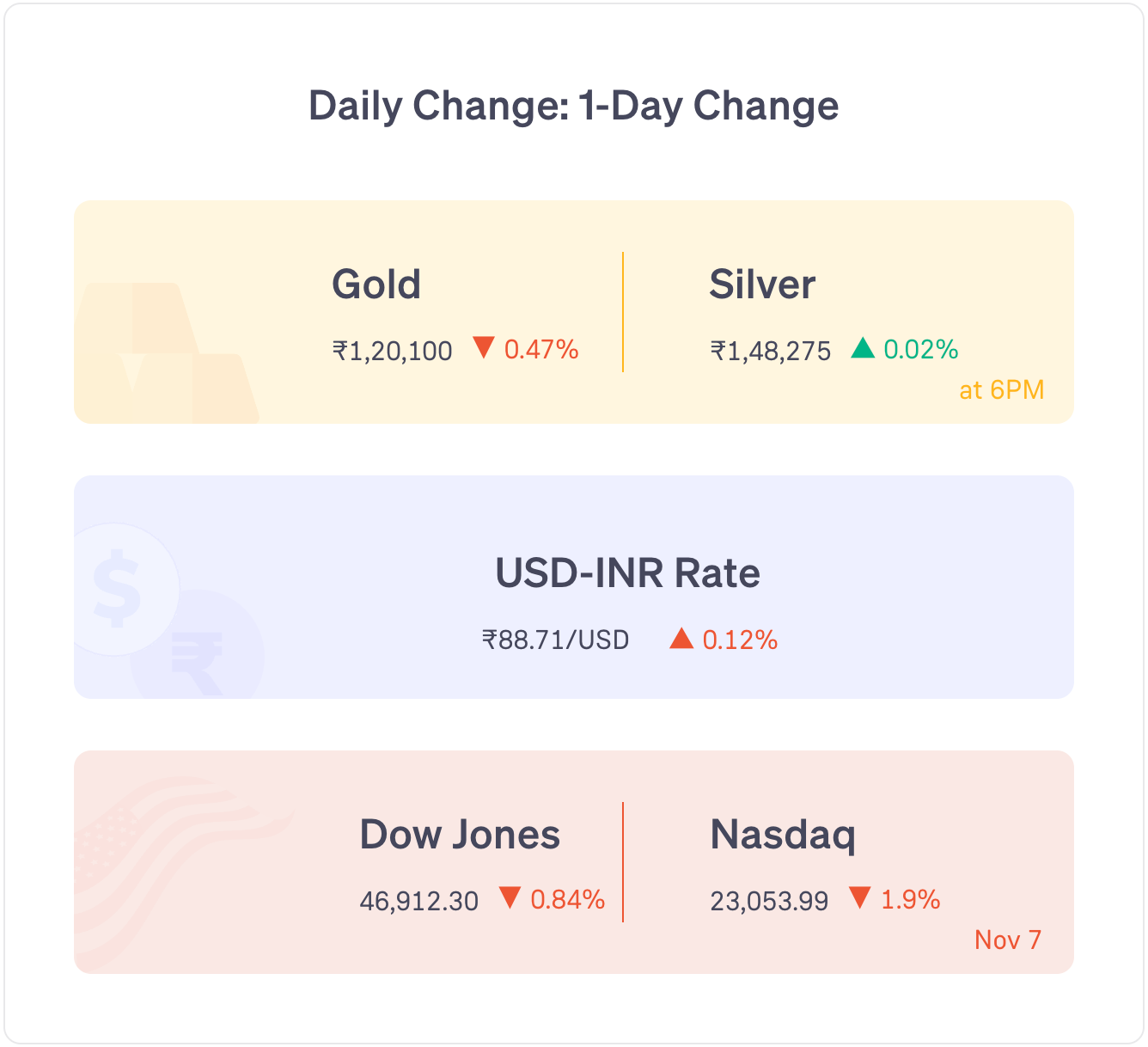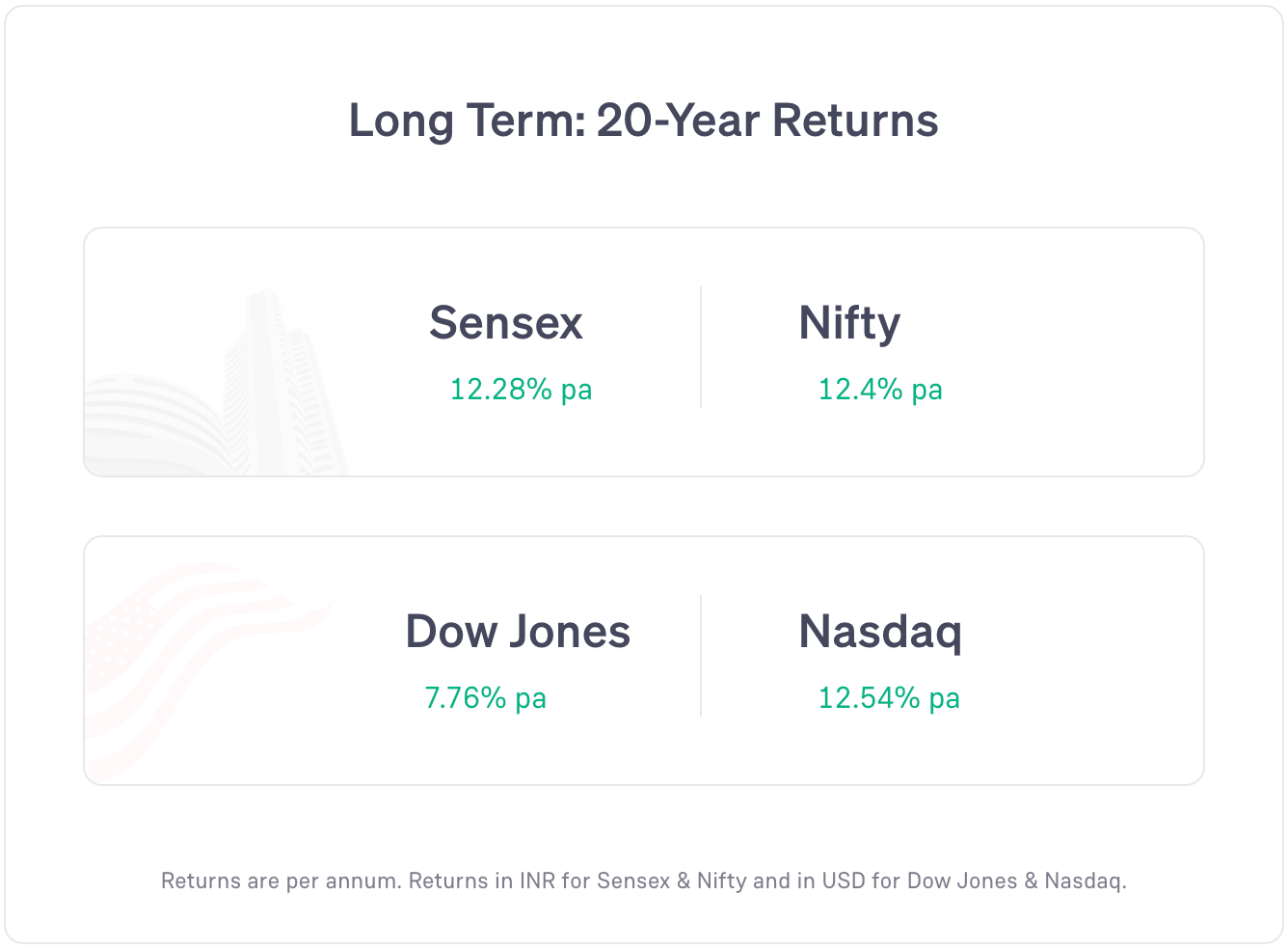Coal India's new JV, Power Finance's Rs 3.65 dividend, & more - Groww Digest
Friday, 7 November 2025
Markets opened below yesterday’s closing point.
Nifty 50 rose throughout the day and closed almost at yesterday’s levels.
Metal stocks and PSU bank stocks rose the most. Consumer durables stocks and IT stocks fell the most.
Global markets: US markets and Asian markets fell. European markets fell too (as of 6 pm IST).
News
India’s forex reserves fell $5.6 billion to $689.73 billion in the week that ended on 31 Oct.
China’s exports fell 1.1% year-on-year in Oct (vs a growth of 8.3% in Sept) while imports rose 1% (vs 7.4% in Sept). The trade surplus narrowed by $38 million in Oct.
Pine Labs IPO has been subscribed 0.13 times. Retail subscription: 0.54 times. IPO closes on 11 Nov.
Note: we will not be covering any news related to the Groww IPO till the listing date (12 Nov) due to legal/conflict-of-interest reasons#
Stocks Updates
Swiggy: board approved raising up to Rs 10,000 crore via QIP (Qualified Institutional Placement).
Coal India: signed a joint venture with Damodar Valley Corporation (DVC) to build a Rs 21,000 crore coal-based power plant at DVC’s Chandrapura site (in Jharkhand) with a 1,600 MW capacity.
BHEL: received a Rs 6,650 crore order from NTPC for the 800 MW Darlipali Supercritical Thermal Power Project Stage-II in Odisha.
Hindustan Aeronautics: signed an agreement with US-based General Electric to supply 113 F404-GE-IN20 engines for 97 LCA Mk1A aircraft.
Zydus Lifesciences: received USFDA tentative approval to manufacture and market Olaparib tablets for cancer treatment in the US.
Infosys: fixed 14 Nov as the record date for its equity share buyback.
Bajaj Auto: net profit rose 53% year-on-year to Rs 2,122 crore in the July-Sept quarter.
Divi’s Labs: net profit rose 35% year-on-year to Rs 689 crore in the July-Sept quarter.
Hindalco: net profit rose 21% year-on-year to Rs 4,741 crore in the July-Sept quarter. It also announced a Rs 10,225 crore expansion at its Aditya Aluminium unit in Odisha.
Trent: net profit rose 11% year-on-year to Rs 377 crore in the July-Sept quarter.
Power Finance Corp: net profit rose 8% year-on-year to Rs 5,743 crore in the July-Sept quarter. Dividend declared: 3.65 per share; record date: 26 Nov.
Torrent Pharma: net profit rose 30% year-on-year to Rs 591 crore in the July-Sept quarter.
Word of the Day
Sovereign Debt
It is the money borrowed by a country’s government
Money is usually borrowed through loans or bonds to fund spending when tax revenues are not enough.
Governments can borrow from domestic as well as foreign investors.
If the government fails to repay on time, it can hurt the country’s credit rating and economy.
Example: when India issues government bonds to raise money for infrastructure, it’s taking on sovereign debt.
6 Day Course
Theme: credit interest cycles
Day 5: Friday
Let’s expand on each phase discussed yesterday.
Easing phase: this phase usually sees economic activity and spending recover as money becomes more easily available.
Businesses start exploring, expanding, and growing. People start becoming less cautious about spending.
Low rate phase: this period marks aggressive spending by all.
Customers are more comfortable spending money on items and services. Companies see higher demand and expand aggressively.
Because interest rates are lower, investors in deposits see lower returns.
So they turn to equities for higher returns — which leads to higher stock market levels. This phase ends with high inflation.
Tightening phase: usually, this happens when inflation is already high. It results in people becoming cautious about spending.
Companies reduce their aggressive-expanding nature.
High rate phase: in this phase, money is less available so very aggressive plans are kept at bay.
Customers too spend less since they have less money in their hands. This in turn leads to more modest revenues/profits for companies.
Deposit investors are happier with the higher returns so they move more money to deposits away from the stock markets so the stock markets are colder.
Featured Question
“Can you explain how gain harvesting works in long-term investing? For example, if someone sells a mutual fund after a 20% gain and reinvests it immediately does this genuinely help reduce tax liability over time, or is its impact often overstated?”
The impact depends on the amount you are investing.
If you are investing a very large amount, the benefit is quite small.
However, for most individual investors, the impact can be meaningful.
In case of mutual funds, long term investments (bought and sold 1+ year later), the tax rate is 12.5% on the gains.
But, the first Rs 1.25 lakh gains are exempt from tax.
So, say you are selling your shares or equity mutual fund, and let’s say you have Rs 2 lakh gains.
12.5% tax will not apply on the entire Rs 2 lakh. It will apply only on Rs 0.75 lakh (Rs 2 lakh - 1.25 lakh exemption).
This exemption is for all combined gains from shares and equity mutual fund investments in a financial year.
What many investors do is they sell a part of their investments every year such that their gains are just under Rs 1.25 lakh per year.
This way, they are able to pay Rs 0 in taxes.
Then, they invest this entire amount back in the same investment.
This way, the ‘buying price’ has been reset at a higher level. So the effective tax rate is a bit lower when you actually take out the money later.
For very large investments, this benefit is smaller.
Say you are investing Rs 1 crore. Then the benefit is tiny.
Did you like this edition?
Leave a feedback here!





Power Finance's divdend yield is realy attractive for income investors. The Rs 3.65 payout shows these PSU finacials can reward patient shareholders. Similar businss development companies in the US offer comparable yeilds too.